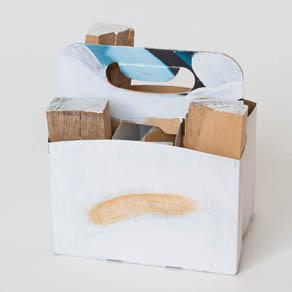exhibitions 2017
Dominik Steiger in curated by_
image/reads/text
Language in Contemporary Art
Shirin Sabahi (*1984, lives in Berlin)
Dominik Steiger (1940–2014, Vienna)
curated by_ Abaseh Mirvali
15. september–21. october 2017
Based on the premise that all forms of communication embody a system of signs, we explore the work of two artists whose practice involves different sets of lingual concerns.
The work by the Austrian artist Dominik Steiger is known for experimenting with written language as well as with image, form, and sound, in the search for new systems of communication. Meanwhile, Iranian artist Shirin Sabahi makes use of established signs, playing with their original definitions by transferring them into new contexts, which at times leads to new meanings.
In his essay, “The Rhetoric of the Image”, Roland Barthes looked into the impact that images have had in our contemporary daily lives and the ways in which we communicate. To him, images transmit as much as linguistic messages, as they too are composed of a series of signs. This certainly is the reason for the special care that so many artists take when selecting the signs for constructing meaning through their visual work.
Coming from the realm of literature and poetry, Dominik Steiger mastered the rhetoric of the image before he began working with visual materials, and was highly aware of the impact that his works had when meeting their viewer. Steiger was a multifaceted artist interested in spontaneity as well as the unconscious. He considered his drawings, collages, bricolages, sculptural assemblages and paintings as extended forms of language that enabled him to communicate certain phenomena, unintelligible otherwise.
Steiger was also a collector. Throughout his life he accumulated objects, from postcards and photographs to bottles, wood residues, and fabrics, that he later used in some of his works. He viewed existing used materials as a source for creation. His series Rollbilder, Bois, and Kulturalcollagen have as a point of departure found and worn objects that the artist used either as primary material or as tools of creation.
Working mainly in film and video, Shirin Sabahi’s body of work contains various by-products that sometimes precede or altogether replace the actual film posters, flip-books, subtitles, trailers, film stills, props, costumes and other things, but excluding the film itself. Though relying heavily on camera-based imagery as both source material and end product, Sabahi’s works often start from writing and from responding to reading as a productive act.
Questions of representation and communication recur in many of Sabahi’s projects. In her film installation, We Came Here to Swim, the protagonist tells a story through sign language, a story about non verbal communication, which ends in an extrasensory dialogue.
Repurposing and recycling are also tools to which Sabahi has returned in her practice, with the change of context ultimately bringing about a different meaning. The Window Session series repeats and consequently codifies anew a geometrical pattern.
The pattern is reminiscent of buildings in crisis, abandoned, in earthquake zones, or during bombing wars of the 20th century, where to minimize the casualties caused by flying glass, windows would be secured by tape. Hinting at the vulnerability of the physical as well as the ideological space of the exhibition, the work plays with a generally discontinued pattern.
Both artists maximize the possibilities of their medium and amplify its limitations. Steiger’s deep imagination and creativity made it possible for him to create an infinity of forms that led him to the inception of an unusual yet meaningful self-language. Similarly, Sabahi’s works, filmic or otherwise, are self-reflexive if not unapologetically self-conscious pieces that expose filmic and architectural languages, while presenting their possible mergers.
Abaseh Mirvali is an independent contemporary art and architecture curator and project producer based in Berlin and Mexico City.
TYPE, PLEASE
curated by_ Sabine Folie
with works of Irma Blank, Melanie Ender, Isabella Kohlhuber, Doris Piwonka, Salome Schmuki, Dominik Steiger and Andrea van der Straeten
15. september–21. october 2017
Irma Blank (*1934)
Melanie Ender (*1984)
Isabella Kohlhuber (*1982)
Doris Piwonka (*1968)
Salome Schmuki (*1979)
Dominik Steiger (1940-2014)
Andrea van der Straeten (*1953)
The title Type, please (2017) is ispired by a work of Salome Schmuki: letters – write, type, speak them. To mistype, to stop, go back, down to the root, to recommence, to get closer, then – surprise: a new word, a new meaning. A wellknown word? Hidden, spilled, hermetic etymology or neologism. Plays on words.
(...)
Sabine Folie is an art historian, free curator, author. From 1998-2008 she was chief curator of the Kunsthalle Wien, from 2008-2014 director of the Generali Foundation, Vienna. Numerous exhibitions, among them Marcel Broodthaers, Politque Poetique (2003) and Un Coup de Dés. Bild gewordene Schrift (Writing turned into image). ABC einer nachdenklichen Sprache (ABC of a thoughtful language) (2008).

Galerie Raum mit Licht, october 2017
Ausstellungen 2019
SKULPTUREN
Altes Mesnerhaus Ausserteuchen

28. Juli bis 24. August 2019, Eröffnung: 27. Juli 2019

















